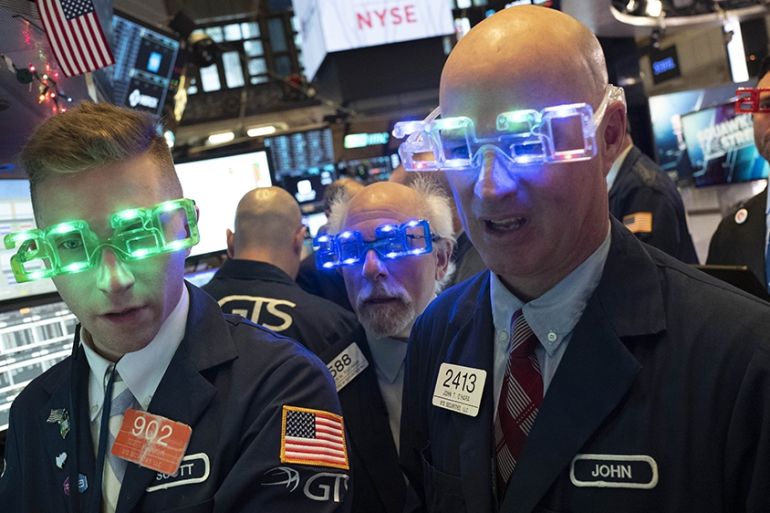Date set for US-China trade deal sends world markets to new high
The Phase 1 trade pact with China will be signed on January 15 at the White House, according to US President Trump

The dollar slid to a six-month low on Tuesday as progress on trade tensions between the United States and China led investors to higher-risk assets, while a year-end rally that lifted global equity markets to record highs stayed alive on the last trading day of 2019.
A gauge of world stock markets and stocks on Wall Street rebounded late in the session after trading lower most of the day, marking an end to a remarkable year for investors. Many equity indices, long-term bonds, oil, and gold posted double-digit gains in 2019.
Keep reading
list of 3 itemsAs the decade ends, traders lock in share market gains
US company directors are being paid more than ever
US President Donald Trump said the Phase 1 trade pact with China would be signed on January 15 at the White House, though confusion remains about details of the agreement.
The hope of an imminent deal has been a key driver for lifting global equities to their best year since 2009, up 24 percent for the year and 88 percent for the decade.
MSCI’s all-country world index of stock performance in 49 nations rose 0.86 points or 0.15 percent, to 565.24. The index is less than three points shy of an all-time high set on Friday when the three major US indices also posted record peaks.
The breakthrough in US-China trade talks and an election in the United Kingdom earlier in December pointing to a smoother exit from the European Union have boosted investor sentiment, but the outlook for equities next year is not as buoyant, said David Kelly, chief global strategist at JPMorgan Asset Management.
“This is a year in which everybody will celebrate,” he said.
Going forward, however, Kelly said it will be hard to achieve similar gains, with US equities likely to advance by mid-single digits annually for several years. International markets, especially emerging markets, are poised to do better, he said.
“The US stock market rally could continue, but at some stage, there’s going to be a significant correction, and the more it goes up, the more it’s going to correct,” he said.
In shortened trading sessions before New Year’s Eve celebrations, the pan-European STOXX 600 index closed down 0.08 percent.
French, British and Spanish listed stocks lost between 0.1 percent and 0.7 percent, while the Frankfurt and Milan bourses were shut for the year-end holidays.
On Wall Street, the Dow Jones Industrial Average rose 76.3 points, or 0.27 percent, to 28,538.44 and the S&P 500 gained 9.49 points, or 0.29 percent, to 3,230.78 The Nasdaq Composite added 26.61 points, or 0.3 percent, to 8,972.60.
Emerging market stocks lost 0.34 percent.
Bourses in Asia diverged. China mainland stocks gained 0.4 percent after data showed manufacturing activity in the world’s second-largest economy expanded for a second straight month in December.
China’s Purchasing Managers’ Index showing economic trends in the manufacturing and service sectors was unchanged at 50.2 in December from November, but still remained above the 50-point mark that separates growth from contraction.
In Hong Kong, stocks fell 0.5 percent as protesters geared up for pro-democracy rallies on New Year’s Eve.
Markets in Japan and South Korea were closed for a holiday.
The dollar’s slide came close to wiping out the year’s gains, as the pound and trade-sensitive currencies rallied on improving US-China trade relations and the outlook for global growth.
The decline of the dollar is one of the biggest bets in the FX market for 2020.
“We could be right at a turning point where global growth re-accelerates relative to US growth, and that could mean a weaker dollar over time,” Kelly said.
The dollar was strong for much of 2019 thanks to the relative outperformance of the US economy and investors’ preference for a safe-haven currency amid the trade dispute. But the dollar’s gains for the year shrivelled in December.
Investors bought up currencies linked to global trade, sending the Australian dollar, Chinese yuan and Scandinavian crowns to multi-month or multi-week highs against the greenback.
The dollar index, which tracks the greenback against a basket of six currencies, fell 0.237 points or 0.24 percent, to 96.503 and the euro was last up 0.14 percent, at $1.1213.
The Japanese yen strengthened 0.22 percent versus the greenback at 108.65 per dollar, while sterling was last trading at $1.3245, up 1.01 percent on the day.
The weak dollar helped lift spot gold to its highest since September 25 at $1,525.20 an ounce. The metal was set to post its biggest yearly gain since 2010, rising more than 18 percent.
US gold futures settled up 0.3 percent at $1,523.10.
The benchmark US Treasury 10-year note fell 7/32 in price to yield 1.9192 percent.
Longer-dated Treasuries were on track to post their best return since 2014 after concerns about the slowing US economy prompted the Federal Reserve to cut interest rates three times this year. The move was a major reason for Wall Street’s gains.
Thirty-year bonds returned 17.15 percent this year through Monday, according to Bank of America Merrill Lynch, while 10-year notes have returned 9.03 percent.
The final data will not be updated until late on Tuesday.
Oil fell but was still on track for monthly and annual gains, supported by a thaw in the prolonged US-China trade dispute and unrest in the Middle East.
Brent crude settled down 67 cents at $66.00 a barrel, while US West Texas Intermediate (WTI) crude slid 62 cents to settle at $61.06 a barrel.
Brent has gained about 23 percent in 2019 and WTI has risen 34 percent, their best yearly gains in three years.